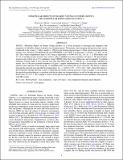Files in this item
Substellar objects in nearby young clusters (SONYC). VIII. Substellar population in Lupus 3
Item metadata
| dc.contributor.author | Mužić, K. | |
| dc.contributor.author | Scholz, A. | |
| dc.contributor.author | Geers, V.C. | |
| dc.contributor.author | Jayawardhana, R. | |
| dc.contributor.author | Martí, B.L. | |
| dc.date.accessioned | 2014-09-01T14:01:03Z | |
| dc.date.available | 2014-09-01T14:01:03Z | |
| dc.date.issued | 2014-04-20 | |
| dc.identifier | 145049200 | |
| dc.identifier | 55bcf6d3-55dd-4a41-9fa6-402ec3b2aaf0 | |
| dc.identifier | 84898008142 | |
| dc.identifier | 000335736800078 | |
| dc.identifier.citation | Mužić , K , Scholz , A , Geers , V C , Jayawardhana , R & Martí , B L 2014 , ' Substellar objects in nearby young clusters (SONYC). VIII. Substellar population in Lupus 3 ' , Astrophysical Journal , vol. 785 , no. 2 , 159 . https://doi.org/10.1088/0004-637X/785/2/159 | en |
| dc.identifier.issn | 0004-637X | |
| dc.identifier.other | BibCode: 2014ApJ...785..159M | |
| dc.identifier.uri | https://hdl.handle.net/10023/5301 | |
| dc.description | This work was co-funded under the Marie Curie Actions of the European Commission (FP7KCOFUND). A.S. acknowledges financial support through the grant 10/RFP/AST2780 from the Science Foundation Ireland. B.L.M. was supported by the Spanish Plan Nacional de Astronomía y Astrofísica through project AYA 2011-30147-C03-03. Support for this work also came from grants to R.J. from the Natural Sciences and Engineering Research Council of Canada. | en |
| dc.description.abstract | SONYC - Substellar Objects in Nearby Young Clusters - is a survey program to investigate the frequency and properties of substellar objects in nearby star-forming regions. We present a new imaging and spectroscopic survey conducted in the young (∼1 Myr), nearby (∼200 pc) star-forming region Lupus 3. Deep optical and near-infrared images were obtained with MOSAIC-II and NEWFIRM at the CTIO 4 m telescope, covering ∼1.4 deg2 on the sky. The i-band completeness limit of 20.3 mag is equivalent to 0.009-0.02 M☉, for AV ≤ 5. Photometry and 11-12 yr baseline proper motions were used to select candidate low-mass members of Lupus 3. We performed a spectroscopic follow-up of 123 candidates, using VIMOS at the Very Large Telescope, and we identify 7 probable members, among which 4 have spectral type later than M6.0 and Teff ≤ 3000 K, i.e., are probably substellar in nature. Two of the new probable members of Lupus 3 appear underluminous for their spectral class and exhibit emission line spectrum with strong Hα or forbidden lines associated with active accretion. We derive a relation between the spectral type and effective temperature: Teff = (4120 ± 175)-(172 ± 26) × SpT, where SpT refers to the M spectral subtype between 1 and 9. Combining our results with the previous works on Lupus 3, we show that the spectral type distribution is consistent with that in other star-forming regions, as well as the derived star-to-brown dwarf ratio of 2.0-3.3. We compile a census of all spectroscopically confirmed low-mass members with spectral type M0 or later. | |
| dc.format.extent | 21 | |
| dc.format.extent | 2313057 | |
| dc.language.iso | eng | |
| dc.relation.ispartof | Astrophysical Journal | en |
| dc.subject | Brown dwarfs | en |
| dc.subject | Stars: formation | en |
| dc.subject | Stars: low-mass | en |
| dc.subject | Stars: luminosity function, mass function | en |
| dc.subject | QB Astronomy | en |
| dc.subject.lcc | QB | en |
| dc.title | Substellar objects in nearby young clusters (SONYC). VIII. Substellar population in Lupus 3 | en |
| dc.type | Journal article | en |
| dc.contributor.institution | University of St Andrews. School of Physics and Astronomy | en |
| dc.identifier.doi | https://doi.org/10.1088/0004-637X/785/2/159 | |
| dc.description.status | Peer reviewed | en |
This item appears in the following Collection(s)
Items in the St Andrews Research Repository are protected by copyright, with all rights reserved, unless otherwise indicated.

